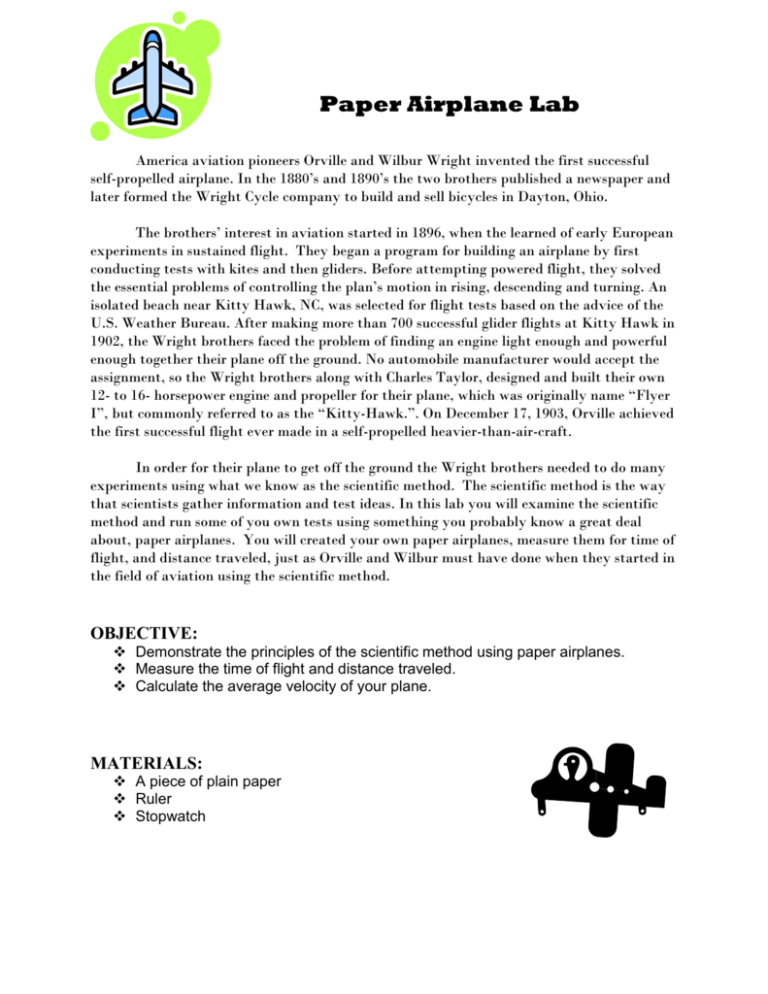Paper Airplane Lab
advertisement

Paper Airplane Lab America aviation pioneers Orville and Wilbur Wright invented the first successful self-propelled airplane. In the 1880’s and 1890’s the two brothers published a newspaper and later formed the Wright Cycle company to build and sell bicycles in Dayton, Ohio. The brothers’ interest in aviation started in 1896, when the learned of early European experiments in sustained flight. They began a program for building an airplane by first conducting tests with kites and then gliders. Before attempting powered flight, they solved the essential problems of controlling the plan’s motion in rising, descending and turning. An isolated beach near Kitty Hawk, NC, was selected for flight tests based on the advice of the U.S. Weather Bureau. After making more than 700 successful glider flights at Kitty Hawk in 1902, the Wright brothers faced the problem of finding an engine light enough and powerful enough together their plane off the ground. No automobile manufacturer would accept the assignment, so the Wright brothers along with Charles Taylor, designed and built their own 12- to 16- horsepower engine and propeller for their plane, which was originally name “Flyer I”, but commonly referred to as the “Kitty-Hawk.”. On December 17, 1903, Orville achieved the first successful flight ever made in a self-propelled heavier-than-air-craft. In order for their plane to get off the ground the Wright brothers needed to do many experiments using what we know as the scientific method. The scientific method is the way that scientists gather information and test ideas. In this lab you will examine the scientific method and run some of you own tests using something you probably know a great deal about, paper airplanes. You will created your own paper airplanes, measure them for time of flight, and distance traveled, just as Orville and Wilbur must have done when they started in the field of aviation using the scientific method. OBJECTIVE: Demonstrate the principles of the scientific method using paper airplanes. Measure the time of flight and distance traveled. Calculate the average velocity of your plane. MATERIALS: A piece of plain paper Ruler Stopwatch PROCEDURE: Part I. Observation: 1. Construct an airplane out of paper. This will be the fist test plane or the Control. 2. Once in the hall, behind the line, throw your airplane. Someone will be keeping time from the time you let go until it touches the ground. The Distance will also be measured from where your plane landed. 3. Record your measurements in the data table. 4. Record your observations of how your plane performed in flight. 5. Calculate the velocity_______________________. Part II: Form a Hypothesis: 6. Make a hypothesis of what you could change on your plane to make it travel further and faster. (add weight, change a fold, add tape) ________________________________________________________________________ _______________________________________________________________________. Part III: The Experiment 7. Make one change to your plane to test your hypothesis. 8. Repeat 2-5. Part IV: Make Observations and Revise Your Hypothesis. 9. Was your hypothesis correct? ___________ Did your velocity improve?______ 10. Record your observations of how your plane performed in flight. 11. Revise your hypothesis. Make a hypothesis of what you could change on your plane to make it travel further and faster. (add weight, change a fold, add tape) ________________________________________________________________________ _______________________________________________________________________. 12. Repeat Part III. Conclusions: 1. What relationship did the size for your plane’s wings have on the distance it flew? ______________________________________________________________________________ ______________________________________________________________________________ 2. List what changes you made to your planes and how each change affected their flight. ______________________________________________________________________________ ______________________________________________________________________________ 3. Could you have had differences in the angle the plane was thrown and/or did more than one person throw the plane? ______________________________________________________________________________ ______________________________________________________________________________ 4. How did you or how could you account for the differences mentions in the previous questions? ______________________________________________________________________________ ______________________________________________________________________________ 5. In which step did you have a control test?___________________________________ 6. Why is it the procedure said to change only on aspect of your plane each time? 7. What were the independent and dependent variables?________________________________ 8. Name the steps of the scientific method you used and give an example of how you used them. ______________________________________________________________________________ ______________________________________________________________________________ Flight # 1 2 3 Distance Traveled Time of Flight Average Velocity Observations








